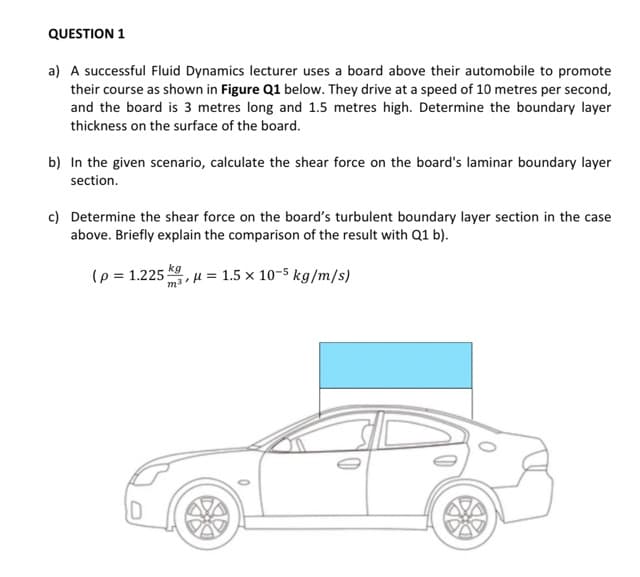a) A successful Fluid Dynamics lecturer uses a board above their automobile to promote their course as shown in Figure Q1 below. They drive at a speed of 10 metres per second, and the board is 3 metres long and 1.5 metres high. Determine the boundary layer thickness on the surface of the board. b) In the given scenario, calculate the shear force on the board's laminar boundary layer section. c) Determine the shear force on the board's turbulent boundary layer section in the case above. Briefly explain the comparison of the result with Q1 b). kg (p= 1.225 = 1.5 x 10-5 kg/m/s) D 0
a) A successful Fluid Dynamics lecturer uses a board above their automobile to promote their course as shown in Figure Q1 below. They drive at a speed of 10 metres per second, and the board is 3 metres long and 1.5 metres high. Determine the boundary layer thickness on the surface of the board. b) In the given scenario, calculate the shear force on the board's laminar boundary layer section. c) Determine the shear force on the board's turbulent boundary layer section in the case above. Briefly explain the comparison of the result with Q1 b). kg (p= 1.225 = 1.5 x 10-5 kg/m/s) D 0
Principles of Heat Transfer (Activate Learning with these NEW titles from Engineering!)
8th Edition
ISBN:9781305387102
Author:Kreith, Frank; Manglik, Raj M.
Publisher:Kreith, Frank; Manglik, Raj M.
Chapter5: Analysis Of Convection Heat Transfer
Section: Chapter Questions
Problem 5.26P
Related questions
Question

Transcribed Image Text:QUESTION 1
a) A successful Fluid Dynamics lecturer uses a board above their automobile to promote
their course as shown in Figure Q1 below. They drive at a speed of 10 metres per second,
and the board is 3 metres long and 1.5 metres high. Determine the boundary layer
thickness on the surface of the board.
b) In the given scenario, calculate the shear force on the board's laminar boundary layer
section.
c) Determine the shear force on the board's turbulent boundary layer section in the case
above. Briefly explain the comparison of the result with Q1 b).
(p= 1.225; u= 1.5 x 10-5 kg/m/s)
kg
m³ μl
Expert Solution
This question has been solved!
Explore an expertly crafted, step-by-step solution for a thorough understanding of key concepts.
Step by step
Solved in 3 steps with 3 images

Knowledge Booster
Learn more about
Need a deep-dive on the concept behind this application? Look no further. Learn more about this topic, mechanical-engineering and related others by exploring similar questions and additional content below.Recommended textbooks for you

Principles of Heat Transfer (Activate Learning wi…
Mechanical Engineering
ISBN:
9781305387102
Author:
Kreith, Frank; Manglik, Raj M.
Publisher:
Cengage Learning

Principles of Heat Transfer (Activate Learning wi…
Mechanical Engineering
ISBN:
9781305387102
Author:
Kreith, Frank; Manglik, Raj M.
Publisher:
Cengage Learning